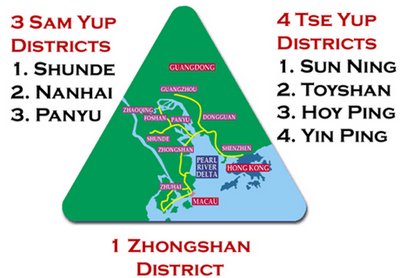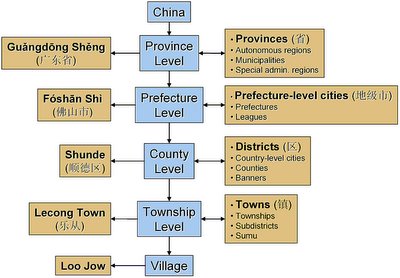4. Guangzhou
For much of the history of the Guangdong Province, the city of Guangzhou (廣州) has been the center of activity. Located in the Pearl River Delta less than 100 miles northwest of Hong Kong, Guangzhou has always been an important trading center and bustling port, given its ready access to the extensive network of inland waterways in Guangdong as well as the coast of Guangdong. Originally called Panyu (番禺), there is evidence that a city has been at this strategic site since 214 BCE. Under the Han Dynasty, Panyu became the seat of the Guang prefecture, and slowly the prefecture name Guangzhou came to supplant Panyu as the city's commonly used name. (a) The Pearl River Delta (dark green) links Guangzhou and the interior of Guangdong province with Hong Kong and Macau (adapted from MIT Foshan Planning Workshop); (b) the city of Canton (Guangzhou) (circa 1864, adapted from The Chinese American Album).
(a) The Pearl River Delta (dark green) links Guangzhou and the interior of Guangdong province with Hong Kong and Macau (adapted from MIT Foshan Planning Workshop); (b) the city of Canton (Guangzhou) (circa 1864, adapted from The Chinese American Album).
Guangzhou has long been a major point of access between China and the rest of the world. In 1711, the British East India Company established a trading post in Guangzhou which would soon become known internationally as Canton (from the French transliteration). Guangzhou’s natural predilection for commerce was further strengthened in 1760 when the Qing government designated the city as China’s sole port for international trade. All foreign warehouses and factories in China were restricted to a section of Guangzhou under the "Canton system." This monopoly on trade lasted until the end of the first Opium War and the Treaty of Nanking in 1842 when Great Britain forced China to open other ports for trade.
Today, “The City of Five Goats” (a name taken from an ancient myth telling of five gods riding five goats who first brought grain to Guangzhou) is similar in size to Chicago with a population of nearly 9.94 million people. Like much of the region, Guangzhou is currently undergoing staggering growth and development. It is the most populous city in Guangdong province and the fifth largest city in China.
 The San Francisco Bay Area has traditionally had very strong ties to Guangzhou and the Pearl River delta surrounding it. Thus, many of the local names and customs are familiar to us. This isn’t surprising when you consider that eighty percent of the Chinese in the Bay Area can trace their ancestry to Guangdong’s Pearl River Delta region. Historically, this region is divided into eight districts: three Sam Yup districts (Shunde, Nanhai, and Panyu); four Tse Yup districts (Sun Ning, Toyshan, Hoy Ping, and Yin Ping); and the district of Zhongshan.
The San Francisco Bay Area has traditionally had very strong ties to Guangzhou and the Pearl River delta surrounding it. Thus, many of the local names and customs are familiar to us. This isn’t surprising when you consider that eighty percent of the Chinese in the Bay Area can trace their ancestry to Guangdong’s Pearl River Delta region. Historically, this region is divided into eight districts: three Sam Yup districts (Shunde, Nanhai, and Panyu); four Tse Yup districts (Sun Ning, Toyshan, Hoy Ping, and Yin Ping); and the district of Zhongshan.
Links:
"San Francisco's streets echo the sounds and sights of Guangzhou" by David Armstrong (SFGate.com, Feb. 26, 2006)
"Cradle of Chinese American culture - Historical impact meets mdern verve in Gunagzhou" by David Armstrong (SFGate.com, Feb. 26, 2006)
Guangzhou (wikipedia.org)
Pearl River Delta tourism
The Chinese American Album by Dorothy & Thomas Hoobler
 (a) The Pearl River Delta (dark green) links Guangzhou and the interior of Guangdong province with Hong Kong and Macau (adapted from MIT Foshan Planning Workshop); (b) the city of Canton (Guangzhou) (circa 1864, adapted from The Chinese American Album).
(a) The Pearl River Delta (dark green) links Guangzhou and the interior of Guangdong province with Hong Kong and Macau (adapted from MIT Foshan Planning Workshop); (b) the city of Canton (Guangzhou) (circa 1864, adapted from The Chinese American Album).Guangzhou has long been a major point of access between China and the rest of the world. In 1711, the British East India Company established a trading post in Guangzhou which would soon become known internationally as Canton (from the French transliteration). Guangzhou’s natural predilection for commerce was further strengthened in 1760 when the Qing government designated the city as China’s sole port for international trade. All foreign warehouses and factories in China were restricted to a section of Guangzhou under the "Canton system." This monopoly on trade lasted until the end of the first Opium War and the Treaty of Nanking in 1842 when Great Britain forced China to open other ports for trade.
Today, “The City of Five Goats” (a name taken from an ancient myth telling of five gods riding five goats who first brought grain to Guangzhou) is similar in size to Chicago with a population of nearly 9.94 million people. Like much of the region, Guangzhou is currently undergoing staggering growth and development. It is the most populous city in Guangdong province and the fifth largest city in China.
 The San Francisco Bay Area has traditionally had very strong ties to Guangzhou and the Pearl River delta surrounding it. Thus, many of the local names and customs are familiar to us. This isn’t surprising when you consider that eighty percent of the Chinese in the Bay Area can trace their ancestry to Guangdong’s Pearl River Delta region. Historically, this region is divided into eight districts: three Sam Yup districts (Shunde, Nanhai, and Panyu); four Tse Yup districts (Sun Ning, Toyshan, Hoy Ping, and Yin Ping); and the district of Zhongshan.
The San Francisco Bay Area has traditionally had very strong ties to Guangzhou and the Pearl River delta surrounding it. Thus, many of the local names and customs are familiar to us. This isn’t surprising when you consider that eighty percent of the Chinese in the Bay Area can trace their ancestry to Guangdong’s Pearl River Delta region. Historically, this region is divided into eight districts: three Sam Yup districts (Shunde, Nanhai, and Panyu); four Tse Yup districts (Sun Ning, Toyshan, Hoy Ping, and Yin Ping); and the district of Zhongshan.Links:
"San Francisco's streets echo the sounds and sights of Guangzhou" by David Armstrong (SFGate.com, Feb. 26, 2006)
"Cradle of Chinese American culture - Historical impact meets mdern verve in Gunagzhou" by David Armstrong (SFGate.com, Feb. 26, 2006)
Guangzhou (wikipedia.org)
Pearl River Delta tourism
The Chinese American Album by Dorothy & Thomas Hoobler









